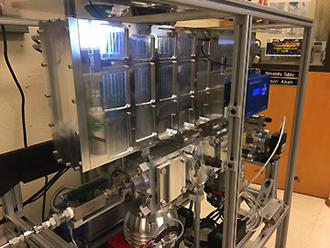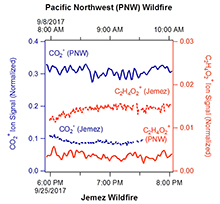-

-
SP-AMS instrument in the CAFE at TA-51.
-
The Laboratory’s first-ever aerosol mass spectrometer (AMS) for direct online measurement of aerosol particles arrived during the end of FY17. The new AMS provides the capability to identify chemical and isotopic signatures of atmospheric processes, high-energy weapons detonations and explosives, and other particulate threats to national security and/or relevant to energy security, production and extraction. The AMS is located at TA-51 in the new Center for Aerosol Forensic Signatures (CAFE), which also includes manipulation via a new oxidation chamber to mimic the aging of particles in the atmosphere along with monitoring the mass, size distribution, optical and hygroscopic properties in real time. In addition to performing controlled laboratory studies on aerosol processes, the AMS can be deployed for campaign-specific needs to field sites for in situ measurements at time resolutions of minutes to seconds. The high time resolution and mass resolving power of the AMS allows for chemically-specific detection of aerosol processes and atmospheric signatures in real time, a new and unique asset for the Lab. The forensics capability is synergistic with big-data initiatives at Los Alamos and DOE.
The instrument could be used to identify signatures of atmospheric processes, weapons and forensics, and other particulate threats to national security. The AMS has different vaporization techniques (tungsten vaporizer and/or 1064 nm intracavity laser), enabling chemical composition to be extracted from solid and liquid phase particles suspended in a gas. The laser vaporizer provides selectivity for particles containing soot formed during combustion processes, e.g. wildfires, high-energy explosions, weapons detonations, power plants, diesel and gasoline engines, etc. The instrument is chemically quantitative for aerosols less than 2.5 microns in diameter, particles in the ambient atmosphere, for inorganic and organic chemical species with detection limits of ng m-3. Particles are sized from approximately 100–3 µm in diameter and reveal mass spectral signatures using time-of-flight mass spectrometry. Size distributions and chemical composition are provided. The AMS samples particles suspended in a gas by using an aerodynamic lens to collimate the aerosol into a particle beam within a differentially pumped vacuum chamber. Particles are vaporized and ionized using 70 eV electron impact ionization. Ions are pulsed and extracted from the ionization chamber orthogonally into the time-of-flight chamber, where the ion trajectories can follow one of two flight paths (1.3 or 2.9 m) within the compact mass spectrometer to obtain mass spectral resolving powers up to 5000 in resolution.
Researchers have used the capability to interrogate fresh and aged wildfire plumes. They identified distinct particle chemistries in the plumes from the distant Pacific Northwest fires and a local lightning-induced burn in the Jemez. The data indicate that organic aerosol dominates both wildfire plumes. The particles from the local Jemez fire were less oxidized and contained primary biomass burning ion signatures.
Ambient aerosol experts Allison C. Aiken and Manvendra Dubey (Earth System Observations, EES-14) collaborated to bring this capability to Los Alamos. The researchers seek to develop synergies utilizing the AMS’s high sensitivity to detect aerosol chemistry for energy and global security needs, including forensic analysis and the ability to detect trace minerals and metals from explosions and high energy combustion sources important to nuclear nonproliferation. Aerosols are a complex system. Understanding their composition, reactions and lifetimes in the atmosphere is critical for insight into climate and national security impacts. The new AMS and aerosol aging chamber provide the capabilities and diagnostics to discover new methods for aerosol forensics detection and atmospheric transformations for the DOE and its partners.
The Principal Associate Director for Science, Technology, and Engineering (PADSTE) and the Associate Directorate for Chemistry, Life, and Earth Sciences (ADCLES) funded the SP-AMS and supporting new aerosol instrumentation. The team has integrated the equipment with other aerosol instruments in the CAFE. The capability supports the Lab’s Global Security mission area and the Science of Signatures science pillar by enabling measurements in support of nuclear nonproliferation, national, and global security. Technical contact: Allison Aiken
-
Ionization chamber and optics to extract ions into the time-of-flight mass spectrometer.

Time series of high resolution ions (CO2+ : oxygen content, C2H4O2+ : levoglucosan). The Jemez fire data came from the Deer Creek fire. Levoglucosan, an organic compound formed when plants are burned, is a tracer for biomass burning. The dominant ion from levoglucosan in the AMS is C2H3O2+. The bottom x-axis is the Jemez wildfire plume timescale. Jemez data are dashed lines. Blue is the left y-axis and all CO2 ion signal. Orange is the right Y-axis and all C2H3O2+ ion signal.
| Period | Sep 27 2017 |
|---|
Media coverage
Media coverage
Title Field deployable aerosol mass spectrometer provides forensic capability for national security Date 09/27/17 Persons Allison C Aiken, Manvendra Krishna Dubey,
Media Type
- STE Highlight
Keywords
- LALP 17-001
STE Mission
- Global Security
STE Pillar
- Science of Signatures